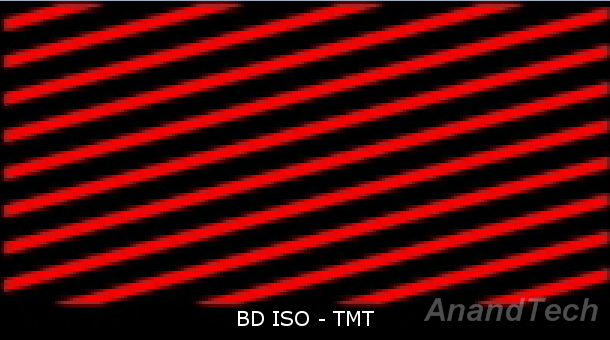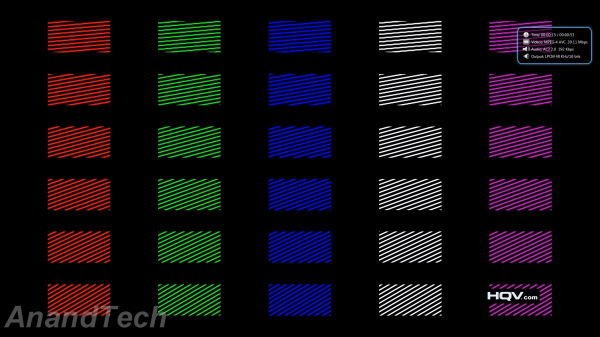AMD Radeon HD 7750 & Radeon HD 7770 GHz Edition Review: Evading The Price/Performance Curve
by Ryan Smith & Ganesh T S on February 15, 2012 12:01 AM EST- Posted in
- GPUs
- AMD
- HTPC
- GCN
- Radeon HD 7000
HQV 2.0 Benchmarking
HTPC enthusiasts are often concerned about the quality of pictures output by the system. While this is a very subjective metric, we have decided to take as much of an objective approach as possible. Over the last year or so, we have been using the HQV 2.0 benchmark for this purpose.
The HQV 2.0 test suite consists of 39 different streams divided into 4 different classes. The playback device is assigned scores for each, depending on how well it plays the stream. Each test was repeated multiple times to ensure that the correct score was assigned. The scoring details are available in the testing guide on the HQV website.
We first played back the benchmarking clips off the Blu-ray, but the scores recorded below are for standalone M2TS playback using CyberLink PowerDVD 12. Our take is that it is standalone files (such as those taken using consumer camcorders and smartphones) which require video post processing more than the already carefully transferred Blu-ray content. If certain driver post processing features are available only for Blu-ray playback, then, it is as good as not being available for consumers to take advantage.
In the table below, we indicate the maximum score possible for each test, and how much the 7750 was able to get with AMD's Catalyst 12.1-based launch drivers.
| AMD 7750 : HQV 2.0 Benchmark | ||||
| Test Class | Chapter | Tests | Max. Score | Radeon HD 7750 |
| Video Conversion | Video Resolution | Dial | 5 | 5 |
| Dial with Static Pattern | 5 | 5 | ||
| Gray Bars | 5 | 5 | ||
| Violin | 5 | 5 | ||
| Film Resolution | Stadium 2:2 | 5 | 5 | |
| Stadium 3:2 | 5 | 5 | ||
| Overlay On Film | Horizontal Text Scroll | 5 | 5 | |
| Vertical Text Scroll | 5 | 5 | ||
| Cadence Response Time | Transition to 3:2 Lock | 5 | 5 | |
| Transition to 2:2 Lock | 5 | 5 | ||
| Multi-Cadence | 2:2:2:4 24 FPS DVCam Video | 5 | 5 | |
| 2:3:3:2 24 FPS DVCam Video | 5 | 5 | ||
| 3:2:3:2:2 24 FPS Vari-Speed | 5 | 5 | ||
| 5:5 12 FPS Animation | 5 | 5 | ||
| 6:4 12 FPS Animation | 5 | 5 | ||
| 8:7 8 FPS Animation | 5 | 5 | ||
| Color Upsampling Errors | Interlace Chroma Problem (ICP) | 5 | 2 | |
| Chroma Upsampling Error (CUE) | 5 | 2 | ||
| Noise and Artifact Reduction | Random Noise | SailBoat | 5 | 5 |
| Flower | 5 | 5 | ||
| Sunrise | 5 | 5 | ||
| Harbour Night | 5 | 5 | ||
| Compression Artifacts | Scrolling Text | 5 | 5 | |
| Roller Coaster | 5 | 5 | ||
| Ferris Wheel | 5 | 5 | ||
| Bridge Traffic | 5 | 5 | ||
| Upscaled Compression Artifacts | Text Pattern | 5 | 3 | |
| Roller Coaster | 5 | 3 | ||
| Ferris Wheel | 5 | 3 | ||
| Bridge Traffic | 5 | 3 | ||
| Image Scaling and Enhancements | Scaling and Filtering | Luminance Frequency Bands | 5 | 5 |
| Chrominance Frequency Bands | 5 | 5 | ||
| Vanishing Text | 5 | 5 | ||
| Resolution Enhancement | Brook, Mountain, Flower, Hair, Wood | 15 | 15 | |
| Video Conversion | Contrast Enhancement | Theme Park | 5 | 5 |
| Driftwood | 5 | 5 | ||
| Beach at Dusk | 5 | 5 | ||
| White and Black Cats | 5 | 5 | ||
| Skin Tone Correction | Skin Tones | 10 | 7 | |
| Total Score | 210 | 193 | ||
We were not able to match what AMD claimed. In all probability, the difference is in the chroma upsampling scores. We already covered this in the Llano review. To recap, the image below is a screen capture while playing the HQV benchmark clip from a Blu-ray ISO on the AMD A8-3850. Note that the light red fringes along the edgs are uniform and extend to the right and the left before tapering off.

Now, let us look at the screen capture when the M2TS is played back using PowerDVD 12 on the Radeon HD 7750.
Zoom into the red stripes on the third row (in the original screenshot) and you can see for yourself that we have some ghost samples extending above and below the actual line of pixels. The screenshot is not at the exact timestamp as that of the Llano sample reproduced above, but the reader should be able to get a general idea of the problem we are hinting at. Readers interested in finding out more about the source of this problem should read up this excellent piece to get more information.
We notified AMD about this issue during the Llano review, but action doesn't seem to have been taken even after 6 months on what is clearly a driver issue. Note that we are not using MPC-HC (which might introduce its own errors in the renderer) in this case, but a standard off-the-shelf commercial player in CyberLink PowerDVD 12. Hopefully, AMD wakes up to this issue soon.











155 Comments
View All Comments
tipoo - Wednesday, February 15, 2012 - link
I probably won't be enticed into a video card upgrade until the next generation of Microsoft and Sony consoles are out. In the land of console ports, even a 6770 can run nearly everything comfortably at most common monitor resolutions.Movieman420 - Wednesday, February 15, 2012 - link
I have an OCd C2D Wolfdale running the 4850 and I also agree that the 4850 will go down as one of the best bang for the buck cards ever.My current i5/Z68 rig is running what I think will be considered another BBFTB card...the 6850...the dual fan Gigabyte 685OC in my case.
The 5770/6770/7770 are a fantastic line of mid-range cards...esp OCd but for a few $$ more an OCd 6850 still holds it's own quite well, there's no real counter for a 256bit vs 128bit memory bus. A big hats off tho to the 7770's high res numbers...pretty damn sweet, but I don't need uber res for a 23.5 inch monitor...ofc I'm not a hard core gamer either.
cjs150 - Wednesday, February 15, 2012 - link
7750 seems perfect for an HTPC. But to put it into context, IGPs should be using the 7750 as the benchmark for what to aim for. Can see this becoming completely obselete very soon once products based on Raspberry pi or Cu Box get released and match (the very impressive) picture quality of the 7750. In mean time get a low profile passive cooled version out and it will be perfect.As for the 7770 I simply see no purpose for it at all. NVidia 560 is only marginally more expensive and beats it completely. 7770 seems to me to be a complete waste of stock
Shadowmaster625 - Wednesday, February 15, 2012 - link
So the 7770 should be at $109, and that forces the 7750 down to $89 or less. The die sizes on these chips are a lot smaller than their competition so I dont see what AMD is thinking. Inflation? lol.Shadowmaster625 - Wednesday, February 15, 2012 - link
Why would a 7750 consumer 3 watts less than a 7770 during the "long idle" state. That really makes no sense. During that state there shouldnt be any difference at all between the two cards.tipoo - Wednesday, February 15, 2012 - link
It has over 100 more stream processors? 3W is pretty minuscule.akbo - Wednesday, February 15, 2012 - link
They are using a gorram 1200W PSU and those have s*** efficiency at 10% load. 3 watts means that it may pull about 1 watt more on-chip.KompuKare - Wednesday, February 15, 2012 - link
Which begs a simple question that has been bothering me with Anandtech GPU reviews for a while: how come they don't measure the wattage for the cards rather the whole system. Ok, it needs a custom PCI-E riser board and a multimeter but other sites (like techpowerup.com or this French site (can't think of it ATM) where the place I first saw that method used) manage it.Or at a minimum why is there no IGPU (Intel 3000) power usage in the review to act as a baseline?
Death666Angel - Wednesday, February 15, 2012 - link
I'm kinda disappointed by the 77xx launch. I'd have hoped for some €150 - €200 cards, consequently performing better than the 6870. Maybe the 78xx will be better. I really hope nVidia comes around with good cards, that way the consumer won't get ripped off. Although I also hope that AMD makes some money in the mean time.geniekid - Wednesday, February 15, 2012 - link
I just want to reiterate how much I appreciate the games you've chosen for your benchmarks. It's a very diverse set of games and covers a lot of the non-FPS genres that other review sites tend to leave out.